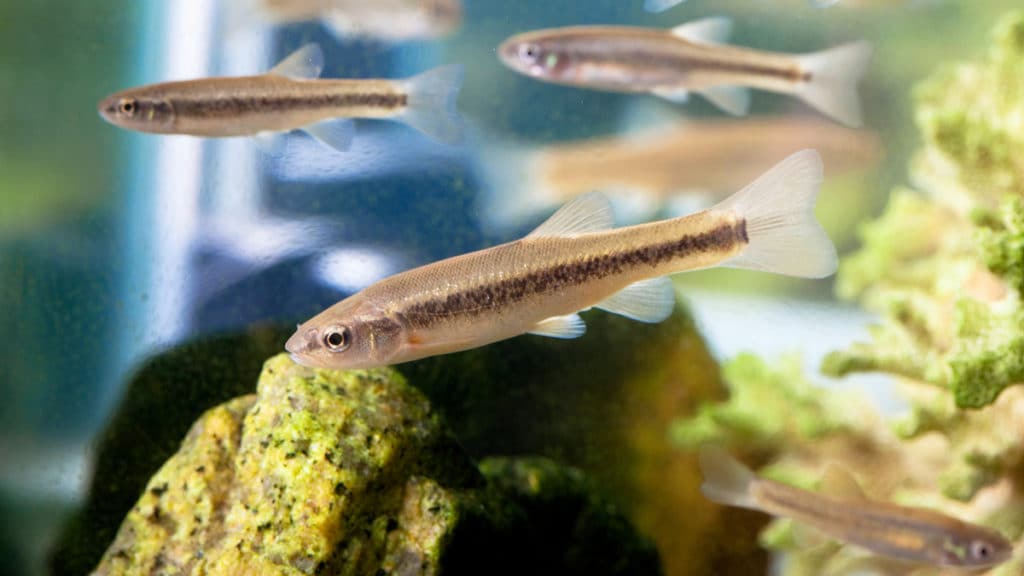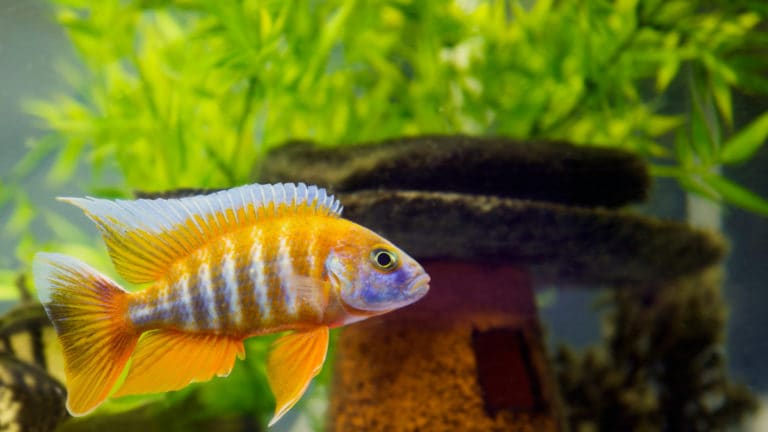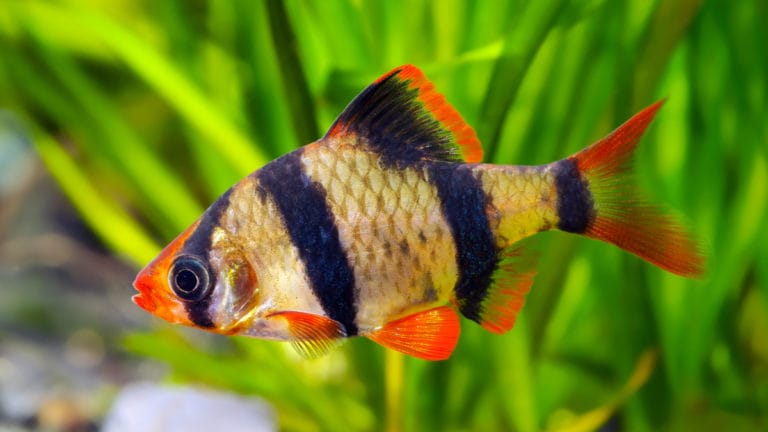The minnows (family Cyprinidae) make up a quarter of all freshwater fish. With about 50 genera and almost 300 species, the United States and Canada have 13 percent of the world’s 2,400 minnow species. Among them are some spectacularly gaudy species — and they are as easy to breed as tetras.
Minnows can be seined in riffles, runs and pools, underneath overhanging banks, and in the largest rivers and smallest creeks. Most male minnows only color up during spring breeding, and during breeding they may scatter eggs over gravel (like danios) or vegetation (like tetras). A few insert eggs into crevices (like Tanganyikan killies) or beneath rocks, and still others construct a cichlid-type nest in the sand or gravel.
Most minnows do well in single-species groups in 20-gallon aquariums with canister or trickling filtration, water changes, powerheads for current and a pebble substratum with rocks. They do well on a diet of flakes, bloodworms, brine shrimp, whiteworms, Grindal worms, blackworms and Daphnia. Most cannot tolerate heat, and some require a chiller.
I’ll be looking at the diverse breeding behaviors of minnows and explaining how to breed them in an aquarium. I’ll cover egg scatterers, egg clusterers, crevice spawners and gravel-mound builders.
Egg Scatterers
The first group I’ll look at are the egg scatterers. This group may breed over clumps of dense vegetation (Nitella, Vesicularia) or over gravel. They produce sticky or nonsticky eggs; stickiness keeps eggs from falling into silt or washing away in current. Minnows with nonsticky eggs often spawn near the bottom, their eggs falling into interstices between pebbles that protect them from currents and predators; some spawn in dense vegetation, which serves the same function.
The largest genus of minnows is Notropis, which are mostly 2- to 4-inch-long, peaceful community fish. Some are red or orange during breeding season. These fish live in the smallest streams where they are easily collected. Many of the prettiest only spawn on the nests of larger minnows, such as Luxilus, Nocomis, Campostoma or Semotilus, in nature. We are still learning which can be induced to breed in aquaria without their host nest-builders.
To try breeding them in a fish aquarium, separate the sexes, and feed them live fish food while keeping them cool and on an 8- to 10-hour light cycle for a month. Then place them together in a larger tank with large gravel or pebbles. Raise the temperature 5 degrees, and increase the light cycle to 12 to 16 hours. Spawning starts in a few days with flashing undulations by the males, fin erection, operculum flaring and color intensification. Nonadhesive eggs are scattered above the gravel or in thick bushy aquatic plants. After spawning, remove the adults. The eggs hatch within five days, and the fry need rotifers, ciliates or other infusoria as a first food.
Another egg scatterer, the northern redbelly dace (Chrosomus eos), ranges from Canada to New York and the upper Missouri River, in lakes, ponds, bogs and creeks. In nature, it eats algae, zooplankton and aquatic insect larvae. It scatters nonadhesive eggs over vegetation. It is also bred in bait ponds with flowing water over mats of algae. The eggs hatch in nine days at 75 degrees Fahrenheit. It hybridizes with Phoxinus neogaeus to form a self-perpetuating false species of diploids and triploids. The male becomes red from the upper jaw along the entire flank. He drives the female into aquatic plants, where they quiver, tetra-style, dropping eggs.
More easily bred and temperature-tolerant is the southern redbelly dace (Chrosomus erythrogaster), which occurs throughout the eastern states in cool and clear upland streams with permanent strong flow, and gravel or rock bottoms. It spawns on riffles, or optionally on the nests of other minnows. You can breed them in a 20-gallon aquarium with current from powerheads. Feed them vegetable flakes supplemented with blackworms, brine shrimp and bloodworms. Use a plastic shoebox with gravel or pebbles as a spawning site. Collect eggs for a week by leaving the box in the adult tank. Then move the box to a separate rearing aquarium before they hatch, providing only sponge filtration. The large fry take Artemia nauplii as a first food, but larger spawns will be raised if they are also provided with green water.
Luxilus have elongated scales in the front of the body, origin of the dorsal fin directly over the origin of the pelvic fins and nine anal fin rays. The nuptial male has prominent hooked tubercles on his snout. These mostly large minnows require 20- to 50-gallon aquaria for a group of six. Most are broadcasters, some spawning over the pits of chubs. Three groups are distinguishable:
- 1. Striped, common, white and crescent shiners are silver with pink overtones. They are characteristic of moderately sloped, medium-sized sandy bottom rivers of Piedmont and foothill regions.
- 2. Warpaint and bandfin shiners have black bands behind the gill cover and black on the dorsal fin, and prefer upper Piedmont slopes with stronger flows.
- 3. Bleeding, cardinal and duskystripe shiners have black bands on the flank, red heads and tails, and occur in small, upland headwater streams with rocky or gravel bottoms.
Care and breeding are similar for all of these. Provide an inch-deep pebble or large-gravel bottom, no rocks or plants, vigorous aeration and moderate current. Cool water is important for conditioning. They spawn when the temperature is increased from 60 to 70 degrees over a period of a month. In the wild, some species may spawn in depressions constructed by pit-building fish. In captivity, any depression is used as a spawning site, or they may broadcast eggs over coarse pea gravel or pebbles, with no depressions apparent or necessary.
They spawn just above the bottom for several hours over a few days. Adults should be removed after spawning, or after several days of bright nuptial coloration and flashing are observed. The eggs in the gravel and pebble spaces hatch in five to eight days. Feed the thin newly hatched fry rotifers, ciliates, algae or finely crushed dry fish food. After a week, the fry hover just above the bottom.
Egg Clusterers
Eggs are clustered in a single layer on the undersurface of a cave roof and guarded by the territorial male. Three genera of minnows are egg clusterers: Pimephales, and the closely related Codoma and Opsopoeodus.
Pimephales contains fathead minnow species, all of which hybridize. Nuptial males have vertical black and white patterns that resemble shadow and light, which provides camouflage in caves. They also have nuptial tubercles on the snout and chin used to excite the females, and modified nape scales forming a cushionlike pad (hence the term fathead) used to brush the eggs on the roof of the nest.
The common fathead minnow (P. promelas) is hatchery-reared as a bait minnow. All fatheads live in small rocky creeks and rivers, in clear water over various bottoms but not among plants. These omnivores are prolific egg-clusterers, producing 40 to 400 eggs per spawn; a nest (usually the underside of a flat rock forming a cave) can sometimes contain up to 5,000 eggs. The male displays as the female nears, both bend into an S-shape, and a single egg is emitted during clasping, then swatted against the cave roof by the female’s tail, where it adheres. The male rubs the eggs with his snout and nape, protecting them from infection and predation.
Seine wild fish or purchase bait fish (tuffies) from bait-and-tackle shops or the domestic orange strain of feeder fish (ruby reds) from pet stores. A bare 10-gallon aquarium with a floss filter outside and sponge filter inside is suitable for one male and four females. You can use halves of 4-inch-diameter PVC pipe as spawning caves, but flat rocks (slate) work fine. Provide at least 16 hours of light. Most spawning is in the morning. Examine the cave every day, and incubate any egg clusters you find in a gallon jar with aeration. Fry are easily raised on Artemia nauplii and powdered flake food.
Crevice Spawners
North American crevice spawners are Cyprinella and Hesperoleucus. Crevice spawners seek tight locations into which they insert eggs, the crevices protecting them from siltation, washing away downcurrent, and to some extent, predation. Crevice spawning is more advanced than broadcasting but less advanced than nesting. Crevice spawners neither construct, nor defend nests, utilizing whatever cracks are available.
Cyprinella contains 24 United States and nine Mexican (with some overlap) species. Their silvery flank scales are higher than they are wide, and they have a dark mark on the chin; there are barbels on the chin in three species. Nuptial males have breeding tubercles on the snout and top of the head; white tips on the unpaired fins; and rich suffusions of red, orange, yellow, blue or green on the body and sometimes the fins.
They produce sounds during nuptial activity. Cyprinella can be found over pebbles and rocks in runs, riffles, pools and sometimes lakes. They spawn several times during the warm months (fractional spawning) rather than all at once. In aquaria, they spawn year-round on spawning mops, over marbles on a bare bottom or in the cracks among piled stones. An excellent substratum is the pleated filter cartridge used in canister fish tank filters for diatomaceous earth filtration. Automobile air filters are not good because the metal screens are toxic, and the pleats are too close together. Cyprinella require live food to bring them into breeding condition.
The satinfin shiner (C. analostana) ranges the Atlantic slope from Lake Ontario drainages southward into South Carolina, on runs and riffles of creeks and rivers, sometimes in lakes. Schools forage on small insects and crustaceans in current close to the bottom. Keep them in groups in a 10-gallon tank or larger. Maintain them on flakes, but condition them for spawning with live blackworms and frozen adult brine shrimp.
They will breed continuously on a pleated aquarium filter cartridge, with the adhesive eggs deposited just inside the crevices. Adults should be removed if the fish spawn on stacked rocks or among plants. If mops are used, pick out the yellow to colorless eggs with your fingers for incubation in shallow dishes with a drop of acriflavine. If a filter cartridge is used, move it to a gallon jar with strong aeration and acriflavine. The elongate, glasslike fry appear in three to four days at 68 degrees Fahrenheit and rest on the bottom the first several days. They need rotifers, protozoa, green water or infusoria for two to three weeks, with Artemia nauplii or vinegar eels offered the second week. Growth is slow, even on live baby brine shrimp, but accelerates after 1 inch when they start feeding on live Daphnia. They will take powdered flake food at a half inch, but whole flakes should be deferred until they are 1 inch long.
The red shiner (C. lutrensis) ranges from Minnesota to the Gulf Coast in creeks and small rivers over sand, rock and gravel, in runs and pools. It spawns in rock and log crevices, at the base of plants, among algal masses and elsewhere. This plasticity in spawning sites; feeding habits; wide use as a baitfish; and tolerance of turbid to clear, fast or slow, warm to cold waters all account for its wide distribution, and threat to other native fish. Thirty years ago, they were popularized in the United States as “African fire barbs.”
Red shiners have been spawned in aquaria utilizing Java moss, stones piled to provide crevices, spawning mops and pleated canister filter cartridges. A 10-gallon aquarium is sufficient for six fish. They spawn readily with canister filter cartridges, and eggs hatch in a week. The fry on the bottom won’t swim for a few days. After hatching, move the fry into a 5-gallon aquarium with aeration, and feed them with green water, rotifers, infusoria or ciliates or APR. After two weeks, they take Artemia nauplii.
Gravel-mound Builders
The river chubs of the genus Nocomis are large, big-headed minnows with dark-edged scales and prominent breeding tubercles on the head of the nuptial male. They all have a barbel at the angle of the jaws, eight dorsal fin rays, seven anal fin rays and a dorsal fin origin slightly ahead of the pelvic fin origin.
The larger, territorial males construct a pit, and they fill it with carefully selected pebbles or gravel to create a mound. A spawning pit or trough (sometimes more than one) is constructed atop the mound. After the spawning clasp and release of eggs into this high pit, the eggs are covered with a mound of gravel. This mound-building behavior is important because other minnows use Nocomis nests as spawning sites, a few species requiring those nests for their own survival.
A 55-gallon-plus aquarium is required for a male and two females. Two inches of pea gravel and river stones should be topped with closely spaced, large, flat rocks, leaving a clearing where the male might con-struct a pit and mound. Use canister or trickling filtration and powerheads for current. Feed them frozen brine shrimp and bloodworms supplemented with chopped earthworms.
Nocomis have not yet been spawned by aquarists, but a large aquarium (125 gallons) might yield success. The horny-head chub (N. biguttatus) is typical of the genus. It occurs in clear streams with gravel, as well as small rivers. Its diet is half plant and half insects. It spawns when temperatures reach 65 degrees Fahrenheit. The male builds a nest of stones and pebbles in shallow water below a riffle, and the mound eventually reaches upward until the nest is one half to 1.5 feet below the surface. Stones often as large as the male’s head are carried in his jaws or pushed with his powerful blunt snout. The height of the nest is determined by the number of spawnings. Later spawnings result in layers of eggs placed on an ever-higher mound. Many other minnows swarm and spawn on the chub nest.
Pteronotropis
Pteronotropis was split out of Notropis for a few Gulf Coast minnows with a broad, blue-black band on the flank, and brilliant yellow or blue colors in the males. In the bluehead shiner (P. hubbsi), two types of males occur: the socially dominant and large terminal males, which defend breeding territories, and the smaller, younger, secondary males, which dart into breeding territories to fertilize what eggs they can.
They live in blackwater swamps and oxbow lakes, often in clumps of hornwort, in deep pools with scattered lilies, and sand and mud bottoms. From April through June, eggs are scattered in warmouth nests or among plant roots. The more colorful, smaller secondary males dart into the nest apparently to spawn when the terminal male is distracted.
Provide yours with a 29-gallon high aquarium with moderate current and plants, leaving the middle unobstructed and the bottom covered with pebbles. Feed them only live foods. Eggs are scattered, so turn off all filters. Remove the adults. The fry take rotifers, infusoria and green water. After two weeks, provide Ceriodaphnia and ostracods, as Artemia nauplii are not readily accepted. You can also use spawning mops on the bottom, then move the mops to aerated gallon jars until the eggs hatch; or you can use a pebble- or marble-filled spawning tray, which can be transferred to a 10- or 20-gallon aquarium for hatching. In all cases, there should be no turbulence in the fry aquarium, as it interferes with feeding.
Protected Minnows
A few minnows are protected because of dwindling populations as desertification spreads and isolated habitats dwindle. A few are threatened by introduced species, such as the rudd and bitterling from Europe, the goldfish and grass carp, bighead and silver carps from Asia, and the common carp from Asia via Europe.
More minnows are depleted because of sportfish and bait introductions to their habitats. Equally egregious is the loss of rivers wrought by power generation and potable water supply neƒfish eds and replacing free-running streams with artificial lakes in which river fish cannot survive.
Contact your state game and fish agency for the laws governing collection and possession of wild native fish in your state.
These minnows exhibit an interesting variety of spawning techniques. If you’re ready to spawn some of these fasci-nating species, give them a try.
Posted by: Chewy Editorial
Featured Image: JUN3/Shutterstock.com
Share:









